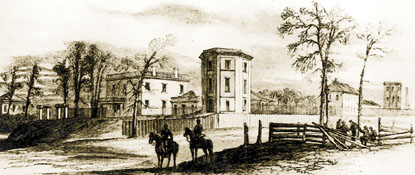28 Oct. 1783–17 Sept. 1867

William Bell, architect and builder of the U.S. Arsenal at Fayetteville, was born in Aberdour, Fifeshire, Scotland. The names of his parents and details of his early life are unknown; but he married Margaret Robinson, became the father of six children, and settled in Edinburgh to practice his profession. In about 1834, influenced by enthusiastic letters from friends who had moved to the United States, he decided to emigrate. He lived for a short time in Yonkers, N.Y., before moving to Washington, D.C., and becoming a member of a firm whose business was the construction of government buildings. In 1835 he was sent to Charleston, S.C., as assistant to Frederick Wesner, the architect for a U.S. Arsenal being built there.
A year later the federal government authorized the construction of another arsenal in Fayetteville, choosing that site because of its central location between Harper's Ferry and Savannah and because of its reputation as an inland port. Bell was commissioned to plan and supervise its construction and began the work in 1838. This arsenal, which played a prominent part in military history during the Civil War, has been described as "the 19th century counterpart of the modern Fort Bragg." The complex of buildings covered nearly 40 acres of a 104-acre tract and was the largest arsenal south of Washington. Intended as a major storage center for muskets in the southern states, it had already received twenty-five thousand muskets by 1840, although the majority of the buildings were far from completion. Planned also as a site for the manufacture of artillery carriage and the repair of arms, the arsenal was considered one of the most important military installations in the country by 1841.
Because of the outbreak of the Civil War, the arsenal was never really completed. On 22 Apr. 1861 it was seized by the State of North Carolina, and on 5 June it was turned over to the Confederacy. This was a highly important event of the war, since the South had no other supply of arms or machinery for manufacturing munitions.
Bell, who was sixty-eight at that time, stayed on as superintendent of the property; and he lived to see it, the most important work of his life, totally destroyed by General Sherman in March 1865. The shock was extreme, and he never recovered from it. He died a year and a half later and was buried in Old Cross Creek Cemetery, Fayetteville.